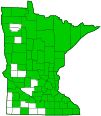common self-heal
(Prunella vulgaris)
Overview • Description • Distribution • Taxonomy
Description |
||
Common self-heal appears as one or more leafy, 4″ to 20″ tall stems. The stems are unbranched and are usually erect, sometimes ascending or nearly prostrate. At the tip of each stem there is a dense, egg-shaped, up to 2″ long, and ¾″ wide spike of many flowers. The purple and white flowers bloom for about a month, sometime between early June and late August, depending on the local climate and the site conditions. |
||
Distribution |
||||
|
Sources |
|||
| 7/7/2022 | ||||
Taxonomy |
|||
| Kingdom | Plantae (green algae and land plants) | ||
| Subkingdom | Viridiplantae (green plants) | ||
| Infrakingdom | Streptophyta (land plants and green algae) | ||
| Superdivision | Embryophyta (land plants) | ||
| Division | Tracheophyta (vascular plants) | ||
| Subdivision | Spermatophytina (seed plants) | ||
| Class | Magnoliopsida (flowering plants) | ||
| Superorder | Asteranae | ||
Order |
Lamiales (mints, plantains, olives, and allies) | ||
Family |
Lamiaceae (mint) | ||
| Subfamily | Nepetoideae | ||
| Tribe | Mentheae | ||
Subtribe |
Prunellinae | ||
| Genus | Prunella (selfheal) | ||
Subordinate Taxa |
|||
Aleutian self-heal (Prunella vulgaris var. aleutica) |
|||
Synonyms |
|||
|
|||
Common Names |
|||
common all-heal common selfheal common self-heal heal-all healall lawn prunella self-heal selfheal |
|||
Visitor Photos |
|||||
Share your photo of this plant. |
|||||
| This button not working for you? Simply email us at info@MinnesotaSeasons.com. Attach one or more photos and, if you like, a caption. |
|||||
Alfredo Colon |
|||||
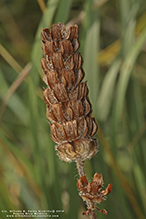 |
|||||
MinnesotaSeasons.com Photos |
|||||
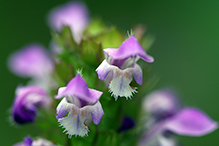 |
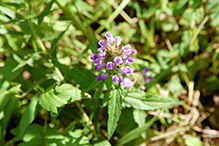 |
||||

Slideshows |
||
| Common Selfheal Wez Smith |
||
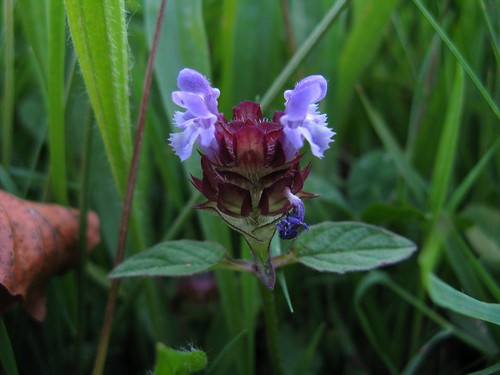
|
||
About
Common Selfheal (Prunella vulgaris). |
||
| Heal-all Andree Reno Sanborn |
||

|
||
About
Prunella vulgaris. Also called self-heal. Heal-all is a fascinating flower. It grows wild almost everywhere and is very common here in northern Vermont. You could even call it a native invasive, so if you plant it, be careful! But if you have no fear of natural herb remedies, it can be a useful plant to invade you. The following paragraphs are from Alternative Nature Online Herbal at www.altnature.com/gallery/healall.htm:Properties Heal-All is edible and medicinal, can be used in salads, soups, stews, or boiled as a pot herb. Used as an alternative medicine for centuries on just about every continent in the world, and for just about every ailment known to man, Heal-All is something of a panacea, it does seem to have some medicinal uses that are constant. The plants most useful constituents are Betulinic-acid, D-Camphor, Delphinidin, Hyperoside, Manganese, Oleanolic-acid, Rosmarinic-acid, Rutin, Ursolic-acid, and Tannins. The whole plant is medicinal as alterative, antibacterial, antipyretic, antiseptic, antispasmodic, astringent, carminative, diuretic, febrifuge, hypotensive, stomachic, styptic, tonic, vermifuge and vulnerary. A cold water infusion of the freshly chopped or dried and powdered leaves is a very tasty and refreshing beverage, weak infusion of the plant is an excellent medicinal eye wash for sties and pinkeye. It is taken internally as a medicinal tea in the treatment of fevers, diarrhoea, sore mouth and throat, internal bleeding, and weaknesses of the liver and heart. Clinical analysis shows it to have an antibacterial action, inhibiting the growth of pseudomonas, Bacillus typhi, E. coli, Mycobacterium tuberculi, which supports its use as an alternative medicine internally and externally as an antibiotic and for hard to heal wounds and diseases. It is showing promise in research for cancer, AIDS, diabetes, and many other maladies.Folklore Once proclaimed to be a Holy herb and thought to be sent by God to cure all ailments of man or beast, and said to drive away the devil, which lead to the belief that Heal-All was grown in the Witches garden as a disguise. The root was used to make a tea to drink in ceremonies before going hunting by one Native American tribe to sharpened the powers of observation.Recipe Medicinal tea or infusion: Add 1 oz. dried or fresh herb to a pint of boiling water, steep till cool, take in ½ cup doses, sweetened with honey, as a general strengthener.Article by Deb Jackson & Karen Bergeron |
||

Visitor Videos |
|||
Share your video of this plant. |
|||
| This button not working for you? Simply email us at info@MinnesotaSeasons.com. Attach a video, a YouTube link, or a cloud storage link. |
|||
Other Videos |
|||
| MyNature Apps; Identifying Selfheal, Prunella vulgaris MyNatureApps |
|||
About
Uploaded on Jul 2, 2011 How to identify Selfheal, Prunella vulgaris also know as Heal-all. www.mynatureapps.com |
|||
| Common Selfheal (Prunella Vulgaris) - 2012-07-02 W3stlander |
|||
About
Published on Jul 4, 2012 Prunella vulgaris, known as common selfheal, heal-all, heart-of-the-earth, is a medicinal plant in the genus Prunella. ------------- |
|||
| Self-Heal (Prunella vulgaris) Wandering Sole TV |
|||
About
Published on Aug 19, 2013 Common self-heal (Prunella vulgaris) or heal-all, gowing along the banks of Lois Creek. A member of the mint (Lamiaceae) family, it grows at low to mid-elevations in moist meadows and along streambanks and lakeshores. Traditional uses for the plant were to assist in healing internal and external bleeding and as a tonic. When used in the making of a medicinal tea, it was drank to treat sore throats, fevers, wounds, diarrhea, internal bleeding, weaknesses of the liver and heart, and disorders of the respiratory tract and infections. The plant is edible and contains vitamin A, vitamin C, vitamin K, flavonoids, and rutin. It appears to have antibacterial properties and research is being done regarding its use in treating for AIDS as well as allergies. |
|||
| Self-Heal or Heal All Tim Goodblood |
|||
About
Published on Jul 20, 2012 Walking Bear shares "heal all". |
|||

Visitor Sightings |
|||||
Report a sighting of this plant. |
|||||
| This button not working for you? Simply email us at info@MinnesotaSeasons.com. Be sure to include a location. |
|||||
| Alfredo Colon 8/9/2019 |
Location: Woodbury, Minnesota |
 |
|||
MinnesotaSeasons.com Sightings |
|||||

|
Created: Last Updated: © MinnesotaSeasons.com. All rights reserved. |
